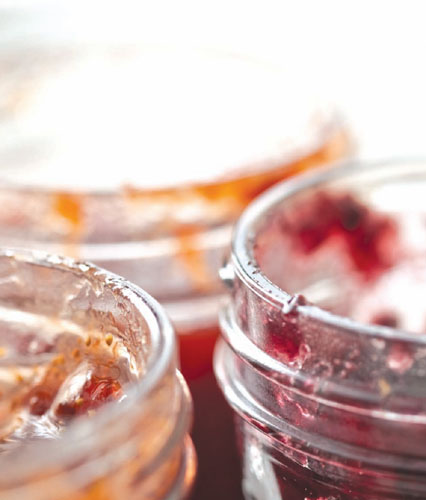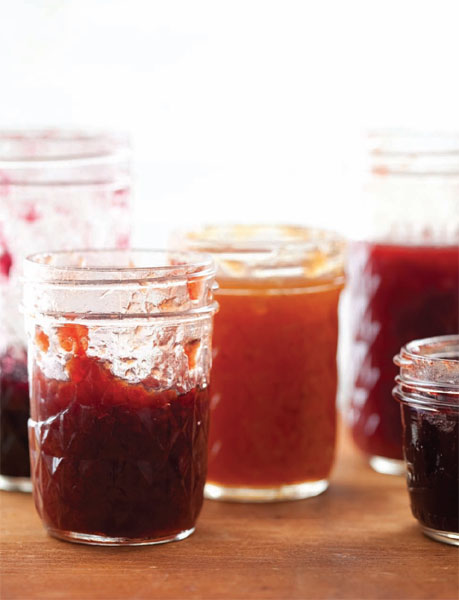Food in Jars (3 page)
Authors: Marisa McClellan

4.
If you're feeling uncertain about your set after you've filled all your jars, take a peek at the remnants of jam in your canning pot. If it sticks and sets to the side of the pan, take heart! The jam should eventually set in the jars as well: give it about 2 weeks.
In the course of learning to can and then sharing my excitement about it, I've heard so many people confess their canning fears. Mostly, they're terrified that they are going to kill their families. Hear me now. If you stick to the high-acid foodsâlike most jams, jellies, and picklesâyou are not going to kill anyone.
Botulism is the singular killer when it comes to canned goods, but it cannot grow in high-acid environments. This means that you'll never hear of a case of botulism having grown in a jar of strawberry jam or dill pickles. If something goes wrong with your high-acid foods, you will be able to tell immediately upon opening the jar. There will be a foul smell, colorful growth, or bubbling where there ought not be (and these things happen very rarely if you're following proper canning procedure).
There are a few varieties of fruit that exist in the very narrow gray area between high acid and low. These items need to be acidified to be canned safely and should be treated with care. This list includes figs, white peaches, Asian pears, bananas, mangoes, watermelon, and tomatoes (we'll get more in depth about how to safely can tomatoes in that section of the book). Take care when working with these fruits and always consult trusted recipe sources like the
Ball Blue Book
and the National Center for Home Food Preservation.
Most low-acid foods can be preserved safely at home with the help of a pressure canner (page 228).
In most of these recipes, I've included suggested cooking times. However, these are just ranges and are not ironclad, particularly when it comes to jams, jellies, and marmalades. Cooking times can vary depending on the humidity in the air, the moisture level in the fruit, the width of your pot and the intensity of your stove's heat. It's important to use your judgment when cooking up these sweet preserves and not just depend solely on the suggested cooking times. Monitoring temperature (see
page 13
) or using the saucer test (see
page 77
) are two good ways to know when the jam is really ready to come off the heat.
Just like cooking times, the yields on these recipes can vary. I have tested and retested the recipes to ensure that they work, but there are a number of factors that can nudge the final amount up or down a few ounces. One particular culprit is a rainy growing season. Lots of precipitation can cause fruits to take on more water while on the plant. This means that during cooking, there will be more liquid that has to be evaporated out of the fruit, leading to smaller yields. Conversely, during hotter, dryer years, the fruit can become intense with sugar (this is why dry-farmed tomatoes and strawberries are so magically delicious) and can yield slightly more product.
One of the quirks of life on earth is that as you increase your elevation, the temperature at which water boils decreases. With every reduction in degree, you lose a bit of bacteria-killing power. If you live between sea level and 1,000 feet, you don't have to make any adjustments and can use the recipes as written. However, for additional altitude, you must add time to the processing step.
1,001 to 3,000 feet 3,001 to 6,000 feet 6,001 to 8,000 feet 8,001 to 10,000 feet | add 5 minutes add 10 minutes add 15 minutes add 20 minutes |


From left to right: Blackberry, Apple-Cranberry, Cantaloupe Vanilla, Sour Cherry, Damson Plum
VANILLA RHUBARB JAM WITH EARL GREY
RHUBARB JAM WITH STRAWBERRIES AND ORANGES
SMALL BATCH MIXED STONE FRUIT JAM
NEARLY SEEDLESS BLACKBERRY SAGE JAM

W
HEN IT COMES TO CANNING, MY FIRST LOVE
will always be jam. There's a certain art and alchemy that takes place when you combine fruit, sugar, and heat that keeps me coming back, season after season.
This doesn't mean that every batch of jam I make is perfect. I've made some jam so firmly set that the knife seems to bounce right off (a small batch of rhubarb jam immediately springs to mind) as well as some that are so runny that the jars slosh when rattled. When that happens, I just call it syrup and tell everyone that I meant to make it like that. Most of the time they believe me.
What's more, every season is a little bit different. Really wet springs can produce strawberries so watery that getting anything beyond juice is a victory and a really hot June will have the blueberries ready for picking a full two weeks early. Don't get complacent and learn to appreciate the variable bounty.
Remember, jam is good for so much more than just smearing on your morning toast or adding to a peanut butter sandwich. Spoon a few dollops into vinaigrette for a fruit-infused salad dressing. Brush a bit on chicken or pork for an instant glaze.
Some of the following recipes call for pectin and some do not. In the recipes that do call for it, they all specify liquid pectin. I prefer a loose-set jam over one that is super firm and I've found that I can best get that consistency with liquid pectin.
For the recipes that do not call for pectin at all, I do recommend that you get yourself a candy thermometer so that you can track the temperature of the jam as it cooks. Jam reaches its set point at 220°F/105°C, so as long as you're able to cook it to that temperature, you should be able to avoid total syrupiness. I use an old-fashioned candy thermometer because it doesn't require batteries and is much harder to break than the electronic ones.
NOTE:
When I make my jams at home, I tend to use the organic evaporated cane juice crystals. While it isn't really any healthier than regular sugar, it has an aura of virtuousness that I like. However, feel free to use conventional white sugar if that's all you have on hand.
Keep in mind that regular jam is absolutely dependent on sugar to achieve a good set, particularly if you're working without additional pectin. If you've ever made candy at home, you'll know how sugar passes through different consistencies as you cook it to ever-higher temperatures. Jam achieves its set point at 220°F/105°C, which in candy making is known as the jelly stage. If you reduce the amount of sugar, you make it harder (or even impossible) for the jam to reach that temperature and achieve set.
If you really want to make reduced- or no-sugar jams, I suggest you look into Pomona's Pectin. It achieves set through a different array of reactions than traditional pectins do. Alternatively, you could also check out the fruit butter section of this book (page 51), which features a number of low-sugar fruit spreads.
 WITH EARL GREY
WITH EARL GREYT
HIS WAS ONE OF THE VERY FIRST JAMS I MADE
that wasn't berry based and I liked it so much that I've made it many times since. In the beginning, the addition of the Earl Grey tea was simply a move to use up the end of a pot, but I find the hint of bergamot flavor it adds is quite nice. However, if you're not a fan, feel free to sub in a different kind of tea or even just water.
8 cups chopped rhubarb (about 3 pounds/1.4 kg rhubarb stalks)
4 cups/800 g granulated sugar
1 cup/240 ml double-strength brewed Earl Grey tea
1 vanilla bean, split and scraped
Juice of 1 lemon
Pinch salt
1 (3-ounce/85 ml) packet liquid pectin
Prepare a boiling water bath and 4 regular-mouth 1-pint/500 ml jars according to the process on page 10. Place the lids in a small saucepan, cover them with water, and simmer over very low heat.
In a large, nonreactive pot, combine the rhubarb, sugar, and tea and bring to a boil. Add the vanilla bean and seeds, lemon juice, and salt to the pot and let the mixture bubble gently over medium-high heat for 15 to 20 minutes, stirring regularly, until the rhubarb has broken down.
Add the packet of liquid pectin and increase the heat to high, to bring the jam up to a rolling boil. Let the jam boil vigorously for 3 to 4 minutes, stirring frequently to prevent the bottom from burning.
Remove the pot from the heat and ladle the jam into the prepared jars. Wipe the rims, apply the lids and rings, and process in a boiling water bath for 10 minutes (see
page 11
).

